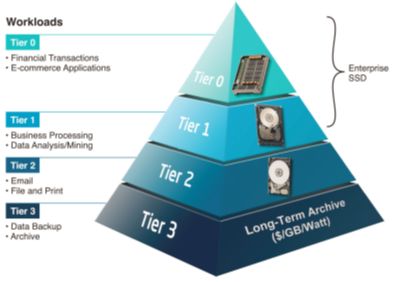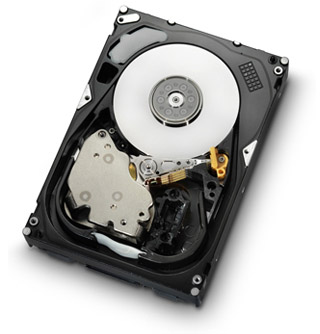Focus on speed: an overview of the "elite" corporate SSD and HDD
 Building a corporate storage system is not an easy task, and to solve it, first of all, you need to decide what data is planned to be stored and, more important, how fast access to it should be. The division of corporate data warehouses by tasks is best illustrated by such a pyramid.
Building a corporate storage system is not an easy task, and to solve it, first of all, you need to decide what data is planned to be stored and, more important, how fast access to it should be. The division of corporate data warehouses by tasks is best illustrated by such a pyramid. Today we will talk about the elite of storage systems - hard drives and solid state drives serving the most demanding systems, where the speed of obtaining information (of course, with the highest reliability) is one of the most important factors. This post is the first in a series of overviews about HGST products. In the near future we will talk about other corporate HDD companies, as well as hard drives for ordinary users.
Dollars, gigabytes and watts
Choosing a hard drive for an enterprise storage system begins with defining the tasks for that very system. Everything is simple here: the faster this data needs to be given, the more productive each element of the system should be. The simplest system is one in which you need to store a lot of data, and the speed of their extraction is not so important. For this task, the most capacious 4-terabyte HGST hard drive that we already wrote about is perfect . Further in increasing order of data storage bandwidth requirements are followed by web servers and cloud systems. Well, at the top - data analysis systems, as well as, for example, services for banking transactions. Here they require everything to the maximum: the speed of reading data, the number of IOPS per second, as well as the minimum access time.
The obvious solution to all performance issues is solid state drives. Indeed, even the fastest HDDs lag behind SSDs in speed, well, not by an order of magnitude, but significantly. But solid state drives also have problems. Firstly, the price exceeds the cost of a fast HDD, and significantly. Secondly, smaller volumes (HGST has a maximum of 400 GB for SSDs versus 1.2 terabytes for 10K RPM HDDs). Thirdly, a small resource of memory cells, although this is partially solved (of course, for an extra charge!) Using more stable flash modules of the type Single-Level Cell.
Returning to the subtitle: in addition to the data transfer speed determined by a specific task, there are three main criteria for choosing a drive: initial investment (how much), volume (how many gigabytes we will get for this money) and energy consumption and overall cost of ownership (how much we will pay each month for maintaining our storage system in good condition). The combination of these parameters leads us to the conclusion that although in the long term SSDs will replace hard drives in the most highly loaded tasks, there is still approximately parity between these types of drives in this area.
And now, more about the models.
15K RPM
 More recently, HDD manufacturers have been experimenting with high-speed hard drives even in the consumer market: before the availability of affordable SSDs, this was the only way to seriously accelerate the work of a powerful home computer. Now, such models have remained only in the corporate series, incorporating the most advanced technologies for storing data on magnetic media.
More recently, HDD manufacturers have been experimenting with high-speed hard drives even in the consumer market: before the availability of affordable SSDs, this was the only way to seriously accelerate the work of a powerful home computer. Now, such models have remained only in the corporate series, incorporating the most advanced technologies for storing data on magnetic media. An example of such a drive is the 3.5-inch HGST Ultrastar C15K600 . Available in versions with a capacity of 300, 450 and 600 gigabytes, it provides a high data exchange rate (up to 198 megabytes per second), supports SAS and Fiber Channel Arbitrated Loop (FCAL) interfaces. All modifications are equipped with a capacious buffer for 64 MB data.
A slightly less speedy but more economical model from the high-speed series is the 2.5-inch Ultrastar C15K147 . Typical power consumption under load for this 147-gigabyte model is 7.3 watts, compared to 16.6 watts for the older model C15K600. This is comparable to the performance of SSD HGST (from 5 watts). Both mentioned models, by the way, are provided with a five-year warranty and have an MBTF of 1.6 million hours (versus 2 million for corporate SSDs and slower Ultrastar 7200 RPM HDDs).
Corporate SSD
 As you know, the main problem with SSDs is the relatively small number of rewriting cycles that solid state drive cells can withstand. There are technologies that allow this limitation to be circumvented, but in a highly loaded corporate storage where SSDs are used “in full” round the clock, this factor cannot be taken into account. Therefore, HGST produces two main modifications of solid-state drives that differ in technology - both relatively inexpensive Multi-Level Cell models ( SSD400M ) and more durable Single-Level Cell ( SSD400S with Flash memory modules made using 34 nm technology and SSD400S.B are available).with more advanced 25nm technology). In all versions, drives are available in volumes of 100, 200 and 400 GB.
As you know, the main problem with SSDs is the relatively small number of rewriting cycles that solid state drive cells can withstand. There are technologies that allow this limitation to be circumvented, but in a highly loaded corporate storage where SSDs are used “in full” round the clock, this factor cannot be taken into account. Therefore, HGST produces two main modifications of solid-state drives that differ in technology - both relatively inexpensive Multi-Level Cell models ( SSD400M ) and more durable Single-Level Cell ( SSD400S with Flash memory modules made using 34 nm technology and SSD400S.B are available).with more advanced 25nm technology). In all versions, drives are available in volumes of 100, 200 and 400 GB. It is noteworthy that HGST drives provide better indicators of the number of rewriting cycles than the industry average. For MLC-drives this is 30,000 cycles (against the standard 10,000), for SLC - 200,000 cycles (against 100,000). Typical power consumption for the SSD400M is 6.5 watts, for the SLC versions - 5.5 watts. Data exchange rates are also “above the market”. For SLC models, the linear read and write speeds are 516 and 458 megabytes per second, respectively. A typical indicator of the number of input-output operations per second (IOPS) is 42,000 for reading and 21,000 for writing (for MLC versions it is slightly higher), and this is almost a hundred times higher than for the fastest HDDs.
In the next article, we will talk about corporate HDDs with a spindle speed of 10 thousand revolutions per minute, providing energy consumption comparable to SSDs - 5.8 watts for the most capacious drive of 1.2 terabytes.
